Beijing
This is the sighted version that was marked on June 16, 2021. There are 4 pending changes that still need to be sighted.
![]()
This article is about the Chinese capital. For other meanings, see Beijing (disambiguation).
![]()
Beijing is a redirect to this article. For other meanings, see Beijing (disambiguation).
Beijing (or according to the Chinese government officially Beijing, Chinese 北京, Pinyin Běijīng, W.-G. Pei-ching - "Northern Capital", [![]()
![]() pei˨˩tɕiŋ˥˥]) is the capital of the People's Republic of China. Beijing has a history of over three thousand years and is now a non-governmental city, meaning that it is directly under the central government and thus equal to provinces, autonomous regions and special administrative zones.
pei˨˩tɕiŋ˥˥]) is the capital of the People's Republic of China. Beijing has a history of over three thousand years and is now a non-governmental city, meaning that it is directly under the central government and thus equal to provinces, autonomous regions and special administrative zones.
The entire 16,807 square kilometer administrative area of Beijing has 21.5 million inhabitants (as of March 2016). It does not represent a contiguous urban area; with its dominant rural settlement structure, it is more comparable to a province. Of the total population, 11.8 million are registered permanent residents (戶口 / 户口, hùkǒu) and 7,7 million temporary residents (流動人口 / 流动人口, liúdòng rénkǒu) with temporary residence permits (暫住證 / 暂住证, zànzhùzhèng). If the core city (high building density and closed place form) is taken as a basis, there are 7.7 million people living in Beijing with their main residence (as of 2007). The metropolitan area (including suburbs) has 11.8 million inhabitants (as of 2007). As of 2018, the metropolis is to become the core of a megalopolis of 130 million inhabitants called Jing-Jin-Ji.
Beijing, as the capital, is the political center of China. Due to its long history, Beijing houses a significant cultural heritage. This includes the traditional residential areas with hutongs, Tian'anmen Square (天安門廣場 / 天安门广场 - "literally Tiananmen Gate Square"), the Forbidden City, which was declared a World Heritage Site by UNESCO in 1987, the New and Old Summer Palace, and various temples, such as the Temple of Heaven, the Temple of Lama, and the Temple of Confucius in 2012.
Etymology
The name Beijing, German Peking (北京, Běijīng), literally means "Northern Capital". In the same way, the names of the cities Nanjing (南京, Nánjīng) for "Southern Capital"' and Tokyo (Japanese 東京 Tōkyō) and Tonkin - in Chinese respectively Dōngjīng (東京 / 东京) - for "Eastern Capital" have been formed.
The name "Beijing" commonly used in German follows the spelling of the old transcription system of the Chinese Post. In High Chinese, the city is pronounced [b̥èɪ̯.d̥ʑ̥íŋ] (![]() ). In the official Pinyin transcription, it is thus spelled Běijīng or Beijing without the tone character.
). In the official Pinyin transcription, it is thus spelled Běijīng or Beijing without the tone character.
In Germany, for example, the German Foreign Office still uses the spelling "Beijing". In German-language publications from China, only the official Chinese spelling "Beijing" is used. The German media have increasingly used this form in recent years. In contrast, the city was historically also called "Pekingen" and "Pecking" in German.
Adaptations
The Pekingese man as well as the dog breed Pekingese are named after the city.
Geography
Geographical position
Beijing is located 110 kilometers northwest of the Bohai Gulf in the middle of Hebei Province, but it is an independently administered non-governmental city with an area of 16,807.8 km², which is roughly equivalent to the land area of the German states of Thuringia or Styria. Of this area, however, only 1,369.9 km² (8%) belong to the core city (high building density and closed urban form). 15,398.4 km² (92 %) consist of suburbs and areas with rural settlement structure. The Beijing metropolitan region, including the suburban belt surrounding the city proper, has an area of 8,859.9 km².
The city is located on the northwestern edge of the densely populated North China Plain an average of 63 meters above sea level and is surrounded by mountains (Mongolian Plateau). The highest elevation in the Beijing administrative region is Ling Shan (more precisely, Dongling Shan 東靈山 / 东灵山) at 2303 meters. In the north-south direction the area extends over 180 km, in the east-west direction over 170 km. Other large cities in the administrative area of Beijing are (as of January 1, 2007): Mentougou 205,574 inhabitants, Tongzhou 169,770 inhabitants, Shunyi 122,264 inhabitants, Huangcun 109,043 inhabitants and Fangshan 100,855 inhabitants.
Geology
The North China Plain (Great Plain), in which Beijing is located, is geologically an intrusion field that was later filled by the delta formations of the North China Rivers. It consists of alluvial loess and sands brought by the rivers from the western mountainous countries. Thus, the plain is a continuation of the loess land.
Also climatically - hot humid summers and dry cold winters with dust storms - and plant geographically - park landscape with steppe-like features - it resembles the neighboring loess mountain countries. The North China Plain represents a huge alluvial cone that the Huang He, the mud-richest river on earth, has piled up over the course of many millennia and whose foothills reach the Yellow Sea to the north and south of the Shandong Peninsula.
The area is subject to strong tectonic stresses that repeatedly lead to earthquakes, which is why the Jiufeng earthquake station was established as early as 1930. The cause is the slow northward shift of the Indian continental plate into the Eurasian continental plate. The speed of plate tectonics is on average about four centimeters per year.
On July 28, 1976, the most momentous earthquake of the 20th century occurred in Tangshan, 140 km east of Beijing (see Tangshan 1976 quake). It had a magnitude of 8.2 on the Richter scale. The official figure given by the government of the People's Republic of China for the number of dead is 242,419, but some estimates give a figure as high as 800,000 dead; the magnitude is also officially given as only 7.8. The quake also caused damage in Beijing and other cities in the region.
City breakdown
Downtown Beijing (marked in red and blue) without suburban belt is composed of six urban districts. On July 1, 2010, Chongwen Municipality (崇文區 / 崇文区, Chóngwén Qū) was incorporated into Dongcheng Municipality and Xuanwu Municipality (宣武區 / 宣武区, Xuānwǔ Qū) was incorporated into Xicheng Municipality.
- Chaoyang (朝陽區 / 朝阳区, Cháoyáng Qū),
- Dongcheng (東城區 / 东城区, Dōngchéng Qū),
- Fengtai (豐台區 / 丰台区, Fēngtái Qū),
- Haidian (海澱區 / 海淀区, 'Hǎidiàn Qū),
- Shijingshan (石景山區 / 石景山区, Shíjǐngshān Qū),
- Xicheng (西城區 / 西城区, Xīchéng Qū),
In the immediate vicinity of downtown Beijing (marked in green) are another six urban districts. These were transformed from counties into urban districts between 1986 and 2001.
- Mentougou (門頭溝區 / 门头沟区, Méntóugōu Qū),
- Fangshan (房山區 / 房山区, Fángshān Qū) - Fangshan County until 1986,
- Tongzhou (通州區 / 通州区, Tōngzhōu Qū) - Tongxian County until 1997,
- Shunyi (順義區 / 顺义区, Shùnyì Qū) - Shunyi County until 1998,
- Changping (昌平區 / 昌平区, Chāngpíng Qū) - Changping County until 1999,
- Daxing (大興區 / 大兴区, Dàxīng Qū) - Daxing County until 2001.
Further away from the inner city area, there are four other urban districts (marked in yellow). These were formed from former districts in 2001 and 2015.
- Pinggu Municipality (平谷區 / 平谷区, Pínggǔ Qū) - Pinggu County until 2001.
- Huairou Municipality (懷柔區 / 怀柔区, Huáiróu Qū) - Huairou County until 2001.
- Miyun Municipality (密雲區 / 密云区, Mìyún Qū),- Miyun County until 2015.
- Yanqing Municipality (延慶區 / 延庆区, Yánqìng Qū).- Yanqing County until 2015.
See also: List of Beijing Municipalities
Climate
Although Beijing is only about 150 kilometers from the coast, it has a temperate, continental climate due to its location in the west wind belt, which means warm, humid summers and cold, dry winters. Annual precipitation averages 578 mm, of which about 62% falls in July and August.
The average annual temperature is 11.8 °C. The warmest month is July, with a mean daily maximum temperature of 30.8 °C and a mean daily minimum temperature of 21.6 °C. The coldest month in the Beijing area is January, with a mean daily maximum temperature of 1.6 °C and a mean daily minimum temperature of -9.6 °C.
Winter brings temperatures as low as -20 °C and an icy wind blowing from the plains of Inner Mongolia. Summer (June to August) is humid and hot with temperatures up to 40 °C, and the short spring (April and May) is dry but windy. Dry and mild weather prevails in autumn (September and October).
When the wind comes from the south or southeast, visibility is zero, especially from June to August. On the other hand, when the wind comes from the north, it gets very cold in the winter, and then there are the sandstorms in the spring. The highest temperature was officially measured on June 15, 1942 with 42.6 °C, the lowest on February 22, 1966 with -27.4 °C.
| Beijing | ||||||||||||||||||||||||||||||||||||||||||||||||
| Climate diagram | ||||||||||||||||||||||||||||||||||||||||||||||||
| ||||||||||||||||||||||||||||||||||||||||||||||||
| Monthly average temperatures and precipitation for Beijing
Source: wetterkontor.de | ||||||||||||||||||||||||||||||||||||||||||||||||||||||||||||||||||||||||||||||||||||||||||||||||||||||||||||||||||||||||||||||||||||||||||||||||||||||||||||||||||||||||||||||||||||||||||||||||||||||||||||||||||||||||||||||||||||||||||||||||||||||||||||
Environmental issues
The Chinese capital is struggling with numerous environmental problems. These include excessive pollution of rivers, problems with drinking water supplies, air pollution, deficits in local public transport and excessive traffic congestion. Since the early 1990s, the government has made increased efforts to promote environmental protection. Laws have been enacted on recycling, environmental impact assessment, energy efficiency and air pollution control.
Stricter exhaust gas regulations were enacted to improve air quality. Since January 1, 2003, only passenger cars that meet the Euro 2 standard have been registered. Since March 1, 2008, all new cars must meet the Euro IV standard. Numerous diesel-powered buses were replaced by natural gas buses. In addition, the share of electrically powered trolley buses in the total of 18,000 buses in Beijing rose to around five percent. Rail-based mass transit, especially the subway network, is also being greatly expanded. However, air pollution in the metropolis remains a cause for concern. The high levels of particulate matter and other air pollutants are a major problem.
As part of the Clean Air Plan, all of the city's coal-fired power plants were decommissioned between 2013 and 2017 and replaced with low-emission gas-fired power plants. A program was also launched to convert coal-fired residential buildings to electric heat pump heating.
According to the World Health Organization (WHO), the capital's air quality is considered one of the worst in the world. The causes lie in the numerous factories and power plants as well as in traffic and private households. Due to rapid urbanization, greatly increased traffic and industrial concentration in metropolitan areas, excessive emissions and smog pose a serious threat to public health. During inversion weather conditions, respiratory diseases in particular increase among the capital's population.

Beijing in August 2005 - left: clear air after rainfall, right: smog in sunny weather
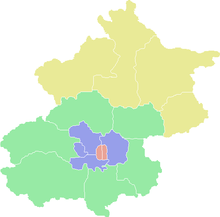
Districts of Beijing (old city marked in red: western and eastern districts)
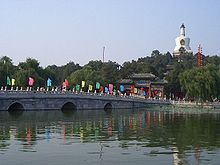
Bridge in Beihai Park - In the background a white pagoda

Landsat image of Beijing, August 2010
History
Prehistory
Representatives of Homo erectus lived in the area of the present-day city of Beijing as early as 770,000 ± 80,000 years ago; they became known under the designation of origin Peking Man after their remains were discovered in the 1920s and 1930s in Zhoukoudian, 50 km southwest of the city center.
Many Oldowan-type stone tools and bone tools were found at the site. In 1987, Zhoukoudian was included in the World Heritage List by UNESCO.
The period until the Yuan Dynasty came to power
Ji (reed) - 1000 B.C.
The history of the city of Beijing dates back to the time of the Western Zhou Dynasty (1121 to 770 BC), when it was named Ji (reed). The city was first mentioned in documents under this name in 1000 BC. Ji was at that time a center for trade with the Mongols and Koreans, as well as various tribes from Shandong and central China.
Yanjing (capital of the Yan) - 475 to 221 BC.
In the period of the Disputed Empires, Beijing was the capital of Yan, which is why the city was named Yanjing (capital of Yan). In 221 BC, the future first emperor Qin Shihuangdi (259-210 BC) occupied the city during his empire unification war. Under his reign, the northern walls were fortified.
Renamed back to Ji (reed) - after 221 BC.
The emperors of the Qin Dynasty changed the name again to Ji. Under their rule, Beijing lost its status as capital to Xianyang as well as its importance.
In the following centuries, Ji developed from an insignificant provincial city into a trading hub and important military base for the defense of China's northern borders, and was occupied several times by steppe and nomadic peoples from the north because of its strategic importance.
Youzhou - 618 to 907 A.D.
During the Tang Dynasty (618-907 AD), the city, now called Youzhou, was ruled by a military governor. It was always overshadowed by the Chinese capital of the time, Chang'an. Only under the foreign rule of the Liao dynasty did Beijing regain some of its former importance.
In 937, the Khitans under Te-kuang (926-947) conquered part of northern China and established their seat of power in Beijing. In 960, the Khitans faced an equal opponent in the Song dynasty. The Song dynasty attempted to reconquer northern China in 979, but was unable to defeat the Khitan general Yelü Hsiu-ko before Beijing. Yelü Hsiu-ko also remained victorious in 986.
Zhongdu (Middle Capital) - 1153 to 1215
After the Jurchen conquest in 1153, Beijing became the capital of the Jin Dynasty and was magnificently expanded under the name Zhongdu ("Middle Capital"). Over 100,000 workers were engaged for the expansion of the city.
Cambaluc / Dadu (City of Khan / Great Capital) - after 1215
In 1215, the armies of Genghis Khan (1162-1227) captured Beijing. They sacked the city and set it on fire. On the old ruins Kublai Khan later had Dadu (the great capital) built, which also became known as Khanbaliq (City of Khan, in Marco Polo Kambaluk). With the creation of the Mongol Empire, the city gained a dominant position during the 13th century.
The rule of the Yuan Dynasty
During the reign of Kublai Khan (1215-1294), the founder of the Yuan Dynasty, Beijing was planned and developed as the Yuan capital under the name Dadu. The city was the main residence of the Mongols from 1264 to 1368. At that time, almost all of East Asia was under the control of Genghis Khan's grandson, and the first Europeans - including, according to their own accounts, Marco Polo (1254-1324) - arrived in Beijing via the famous Silk Road.
Marco Polo, who was Kublai's guest and worked in the city for a while, was extremely impressed in view of the great sophistication: "So numerous are houses and people that no one could name their number... I think there is no place in the world that sees so many merchants, so many precious and peculiar goods and treasures, as come into this from all directions..."
The wealth was due to the city's location at the starting point of the Silk Road, and according to Polo's descriptions, there were "almost daily more than one thousand carts loaded with silk" that arrived in the city to begin their onward journey from there to lands west of China.
In an unprecedented display of style and splendor for the Great Khans, who were later called emperors, Kublai built himself a palace of enormous proportions, protected on all sides by walls and accessible by marble staircases.
Power Development under the Ming and Qing Dynasties
In 1368, the Yuan Dynasty was succeeded by the Ming Dynasty. Hongwu (1328-1398), the first emperor of the Ming Dynasty, had his capital built in Nanjing (Southern Capital) on the Yangzi River and changed the name of Dadu to Beiping (北平, Běipíng, Pei-p'ing - "Northern Peace").
Starting in 1408, Emperor Yongle began to completely rebuild the city under its new name Beijing (Northern Capital). He created, among other things, the Forbidden City and the Temple of Heaven, with which Yongle prefigured important elements of the city's development. In 1421, Yongle designated Beijing as the new capital of the Ming Dynasty. During the following Qing Dynasty (1644-1911), the city was expanded with more temples and palaces. This period was marked by the rise and fall of the Manchu and Qing dynasties, respectively.
The capital experienced its greatest heyday during the first half of the 18th century under the emperors Kangxi, Yongzheng and Qianlong. During that period, the Qing also built the legendary Summer Palace north of the city, a garden complex for the nobility that was unique in the world, with 200 pavilions, temples and palace buildings against the backdrop of a vast landscape of man-made lakes and hills. Together with the imperial palace, it formed the center and symbol of Chinese glory and power.
However, in the Second Opium War, British and French troops advanced to the walls of the capital in 1860, and the Summer Palace was first looted and then set on fire by the British, burning it practically to the ground. While the imperial court lived in a separate walled city in a spacious area, the civilian population had to live in inhumane conditions.
With funds actually intended for the modernization of the Chinese navy, Empress Dowager Cixi (1835-1908) began building a new summer palace for herself starting in 1884. Her project marked the end of imperial building glory and patronage as the last great symbol - and like its predecessor, was devastated by fire by foreign soldiers during the Boxer Rebellion in 1900. At that time, the empire and the imperial capital were on the verge of collapse as a result of successive waves of foreign occupation.
Beijing after the abdication of the Manchu
After the abdication of the Manchus and the establishment of the Republic of China in 1912, Beijing remained the political center of China until 1928. Then Chiang Kai-shek (1887-1975) established the capital in Nanjing. Beijing was under the control of rival warlords and was therefore renamed Beiping (Northern Peace) again by the Kuomintang in 1928 to make it clear that it was not a capital.
During the turbulent 1920s, Beijing saw mass demonstrations by residents, first in 1925 to protest the massacre of Chinese demonstrators in Shanghai by British soldiers, and in 1926 to voice their displeasure over the government's ignominious surrender to Japan in the Manchurian crisis. As the demonstrators marched toward government offices, soldiers opened fire on them.
The city was occupied by the Japanese army during the Marco Polo Bridge (Lugouqiao) Incident at the beginning of the Second Sino-Japanese War on July 19, 1937. Only after the end of the Pacific War was the city liberated by Kuomintang and US Marines in 1945.
The period since the communists came to power
In January 1949, the Communists captured Beijing - nine months before Chiang Kai-shek's flight to Taiwan made the final victory a certainty. Following the founding of the People's Republic of China by Mao Zedong on October 1, 1949, the Communist government again declared Beijing the capital.
Rebuilding the capital and eradicating the symbols of previous regimes were top priorities for the new rulers. In order to free themselves from the past and build a modern capital of the people, much of the valuable old building fabric was destroyed or misappropriated. For example, the Temple of Cherished Wisdom was converted into a wire factory and light bulbs were manufactured in the Temple of the Fire God. In the 1940s, the city still had 8,000 temples and monuments; in the 1960s, this number had shrunk to 150.
Beijing became the scene of a massive popular uprising in 1989, when nearly a million demonstrators in Tian'anmen Square in the center of the city between April and June of that year made known their displeasure with the slow pace of reform, the lack of freedom and widespread corruption. A giant statue, the Goddess of Freedom, which was seen carrying a torch in both hands, was made by art students and juxtaposed with the portrait of Mao Zedong in Tiananmen Square.
As a result, the Chinese government imposed martial law on May 20 of that year. On June 4, 1989, the peaceful democracy movement was bloodily crushed by the army; thousands of civilians were killed.
On October 20, 1998, the country's first human rights conference opened in Beijing. The conference was attended by more than 100 representatives from 27 countries. - In July 2001, the International Olympic Committee declared Beijing the venue for the 2008 Summer Olympics.
The biggest problems facing the city today because of failed (modern) urban planning policies are growing immigration, air pollution caused by aging factories, and sprawling traffic that brings the city to the brink of gridlock and contributes its share to poor air quality.
Population development
As early as 1450, 600,000 people lived in Beijing. By 1800, the city's population had risen to 1.1 million. After a temporary decline to 693,000 by 1900, the population grew to 1.6 million by 1930 and 2.8 million by 1953. In 2007, 7.7 million people lived in the core city (high building density and closed village form), two and a half times as many as in 1953. The population density is 5639 inhabitants per square kilometer. The metropolitan region of Beijing, which includes the suburban belt surrounding the city proper, had 11.8 million inhabitants in 2007. The population density in 2007 was 1337 inhabitants per square kilometer.
The entire administrative area of the government-immediate city of Beijing, which includes extensive rural areas, has a population of 21.7 million (2015). Of these, 13.5 million are registered permanent residents (戶口 / 户口, hùkǒu) and 8,2 million temporary residents (流動人口 / 流动人口, liúdòng rénkǒu) with temporary residence permits (暫住證 / 暂住证, zànzhùzhèng).
Anyone wishing to stay in the city for more than three days must report to the Public Security Office and is registered there. The applicant then receives a temporary residence permit for three months, which must be renewed at the end of the period. A certificate from the place of origin must be presented at the office, confirming that the person is registered there. The city is also home to about one million guest workers, mostly unskilled migrant workers and illegal immigrants, who are not covered by official statistics. Since the birth rate is low, population growth is mainly due to immigration. The natural increase of the population with permanent residence in Beijing is currently 0.9 per 1000 inhabitants, birth rate: 6.0 per 1000 inhabitants, death rate: 5.1 per 1000 inhabitants.
About 95.7 % of the population is Han. The largest ethnic minority, with over 1.8 % of the population, are the Manchus; with 1.74 %, the Muslim Hui Chinese are in second place. There are also notable groups of Mongolians (0.3 % of Beijing's population) and Koreans (0.15 %). All of China's ethnic groups are also represented in small numbers among Beijing's residents; quantitatively, the De'ang, a Mon-Khmer people, rank last with four residents. The Chinese spoken in Beijing largely corresponds to High Chinese (Putonghua), the official language of the People's Republic of China, with some colloquial inflections.
The following overview shows the population figures for the core city (excluding the suburban belt). Listed are the registered residents with main residence in Beijing.
|
|
|
Development of the housing situation
According to Forbes' 2009 list of the World's Most Expensive Cities To Live, Beijing is considered a city with a very high cost of living and one of the most expensive cities in the world. In a 2018 ranking of cities by quality of life, Beijing ranked 119th among 231 cities surveyed worldwide.
Many elements of modern urban planning policy had devastating consequences for the population and created more problems than they solved. A large part of the traditional courtyard houses (siheyuan) in the narrow alleys (hutongs), which were considered a breeding ground for individualists, have been demolished since 1949. Their place was taken by anonymous new buildings made of concrete, often with inadequate sanitary facilities and hardly any running water.
When extensive renovation work on the buildings seemed urgently needed in the late 1960s, an underground network of tunnels was created instead to provide protection in the event of war. Millions of man-hours were invested in the project, which could not provide protection against modern bombs and ultimately only led to the lowering of the groundwater level.
In 1950, the government initiated the killing of all dogs in the Chinese capital. The killing of numerous sparrows in 1956 - the measure was originally intended to protect grain stocks - had the sole effect of allowing insects to multiply more. To counteract this, the city government ordered the removal of all green spaces in the capital, which in turn caused dust storms during the windy winter months.
At the beginning of the new millennium, major urban redevelopment projects were underway to prepare Beijing for the 2008 Summer Olympics. Various efforts to curb air pollution have already been made; factories that could not be further modernized have been forced to close. Open spaces have been given a new lease of life through extensive greening. Polluted sewers have been dredged.
As the lodestar on China's path to modernity, Beijing is leading the way in transforming the country. Buildings are being demolished and new ones erected at a rapid pace, to which the white character 拆 (chāi for demolition) on old houses and the many construction cranes bear impressive witness. In the city center, mainly modern concrete and glass buildings are being erected, and numerous office complexes are being built along the wide main thoroughfares. For the poorer sections of the population, the apartments there are not affordable. They are being displaced to the outskirts of the city.
Most of Beijing's residents live in high-rise buildings. Two residential areas are particularly important for this: the Wangjing area in the northeast and the Huilongguan residential area in the northwest. To address the problem of overcrowding, a number of satellite cities for more than 500,000 residents each are under construction and planned as part of large-scale construction measures.
.jpg)
Entrance to the alleys of a traditional hutong in Beijing

Residential building in Chaoyang district
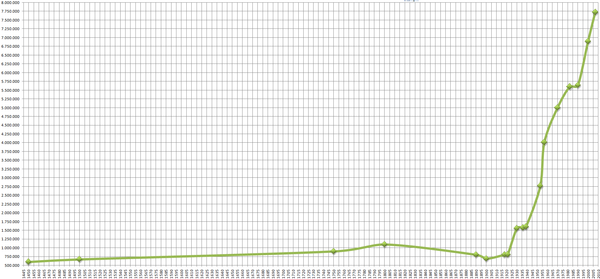
Population development of Beijing
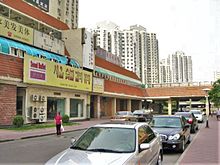
Wangjing
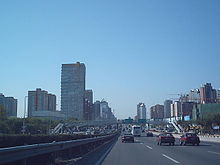
Beijing skyline

Beijing traffic

Chang'an Avenue

Map of Beijing and its environs (about 1930)
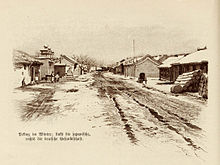
German and Japanese legation building in Beijing 1898

The old city wall, around 1900
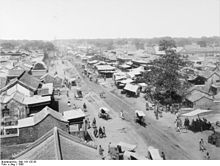
Beijing 1898

Wansong Pagoda

Palace in Beijing, historical drawing
Politics
City government
The mayor of Beijing since May 2017 is Chen Jining (* 1964). His predecessor was Guo Jinlong from November 2007 until his resignation in July 2012. Guo was born in Nanjing in July 1947 and was most recently party secretary of Anhui and is a member of the Central Committee of the CP of China. His predecessor was Wang Qishan, born in July 1948 in Shanxitian Township near Qingdao City. He took over the post on April 22, 2003, from Meng Xuenong, who was removed from his post by the Chinese Communist Party for misconduct during the SARS outbreak in the capital.
Meng Xuenong was blamed for a policy of cover-up and concealment that sought to hide the SARS outbreak for a long time. SARS had sickened several thousand people in Beijing and killed hundreds. Meng Xuenong took over as mayor from Liu Qi on January 19, 2003.
Other members of the Beijing municipal government include Party Committee Secretary Liu Qi, Chairman of the Standing Committee of the People's Congress Yu Junbo, and Chairwoman of the Chinese People's Political Consultative Conference (PKKCV) Cheng Shi'e. The PKKCV is composed of the National Committee and local committees at various levels.
The city government is responsible for the governments of 16 city districts and two counties. The urban districts are in turn subdivided into street districts, and in some cases also into communes, large communes and "subdistricts" (at the commune level). The counties, on the other hand, are composed of communes and large municipalities; only Miyun County, which has developed a small urban center, has two street districts. At the bottom of Beijing's administrative pyramid in urban areas are the so-called residents' communities (社區 / 社区, shèqū), which are governed by residents' committees (居民委員會 / 居民委员会, jūmín wěiyuánhùi) and, in rural areas, villages (村, cūn) administered by village committees (村民委員會 / 村民委员会, cūnmín wěiyuánhùi).
See also: List of mayors of the city of Beijing
Town twinning
Beijing maintains partnerships with the following cities:
| United States Serbia Peru United States Spain Brazil Germany Turkey Egypt Indonesia Pakistan Thailand Argentina Korea Sud Ukraine Germany Belgium Vietnam | Netherlands Russia France Italy Canada Australia Greece Hungary Romania Cuba Philippines United Kingdom Athiopia New Zealand Finland Kazakhstan Israel Portugal |
Regional partnerships
Beijing has partnerships with the following regions:
Japan ![]() since March 14, 1979: Tokyo Prefecture, Japan
since March 14, 1979: Tokyo Prefecture, Japan
France ![]() since July 2, 1987: Île-de-France, France
since July 2, 1987: Île-de-France, France
Sud Africa![]() since December 6, 1998: Gauteng Province, South Africa
since December 6, 1998: Gauteng Province, South Africa
Spain ![]() since January 17, 2005: Autonomous Community of Madrid, Spain
since January 17, 2005: Autonomous Community of Madrid, Spain
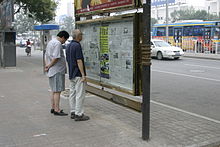
Newspaper reader in Beijing
Culture and sights
Music and theater
There are numerous theaters (for example, the People's Theater), as well as the Beijing Concert Hall for musical events. The famous Peking Opera is named after Beijing, which is a special mixture of different art forms, such as singing, dancing, acrobatics and mimic play. The plot is usually based on historical or mythological material.
Contemporary theater, on the other hand, is changing rapidly, with recent Chinese translations of Western plays and experimental productions by local dramaturges.
Speech theater did not make its way onto Chinese stages until the 20th century. Its home became the People's Art Theater in Beijing, where European plays with a clear social message were shown before the Cultural Revolution. In 1968, however, this art form was banned by Jiang Qing, Mao Zedong's third wife, except for a few plays - which were deemed edifying to society. The theater and most cinemas were closed for about ten years.
The broadcasting station China National Radio (CNR) has its own concert hall with excellent acoustics. This concert hall is also the broadcasting hall, where many concerts are recorded or broadcast directly to the whole country. One of the largest organs in China is located in this concert hall, it originates from Germany and was built in 1999 by the company Gebr. Oberlinger Orgelbau based in Windesheim, Rhineland-Palatinate.
Museums
Beijing's museums house some of the most important collections of Chinese traditional art and archaeological artifacts, including the National Art Museum and the Capital Museum. In addition, Beijing also has a Natural History Museum and a large Museum of Technology and Science.
The result of a Qing emperor's passion for collecting is on display in an unusual clock museum in the Imperial Palace in the Forbidden City. Most of the exhibits are exuberant examples of Baroque ornamentation from Britain and France, but perhaps most impressive is the huge Chinese water clock.
Beijing has become a center of contemporary, especially Chinese, art in recent years. Most of the more sophisticated exhibitions take place in private galleries. Many are concentrated in so-called art districts, mostly in former factory buildings, such as 798, Caochangdi or Jiuchang. In the city center, the Courtyard Gallery in Donghuamen Dajie and the Red Gate Gallery are the best known.
60 kilometers north of the city is the Aviation Museum. In a huge hangar and exhibition hall, more than 300 aircraft are on display, ranging from a replica of the Wright brothers' plane piloted by Feng Ru (1883-1912), the first Chinese aircraft engineer and pilot in 1909, to attack helicopters used in the First Gulf War. The collection also includes fighter planes from the Korean War, the bomber that dropped China's first atomic bomb in 1964, Mao Zedong's personal plane and the plane from which Zhou Enlai's ashes were scattered.
There is also a museum about the Anti-Japanese War in Beijing.
Buildings
Old Town and Imperial Palace
Originally surrounded by a large wall, the Old City of Beijing was planned as an image of the cosmos - from Greek kósmos = the world [order] - and consisted of three rectangular districts (Imperial, Inner and Outer City). On the main axis of the Old City, in the north-south direction, were gate buildings, palace and ceremonial buildings. The Forbidden City - it was originally not accessible to the common people - houses the former imperial palace, surrounded by a wall and declared a World Heritage Site by UNESCO in 1987. The site served as a residence for 24 Chinese emperors of the Ming and Qing dynasties and their families. Today, the Forbidden City houses the Beijing Palace Museum.
The Old City consisted of the Outer City and the square Inner City located in the northern part, built from 1409 to 1420 and surrounded by a wide wall 15 meters high with nine gates. The boundaries of the Inner City largely corresponded to those of the capital city of Dadu in the Yuan Dynasty (1271-1368). Within the Inner City was the Imperial City, which contained government buildings, palaces, temples, gardens and parks, and the Forbidden City. Outside the Imperial City were quarters with markets and temples, as well as residential quarters. The wall was about 25 kilometers long.
Located in the southern part, the Outer City was built during the Ming Dynasty between 1521 and 1566. It was rectangular and had a wall 23.5 kilometers long. There were important temple districts as well as residential districts for the common people in this area. After the Communists took power in China on October 1, 1949, the old city walls of Beijing were demolished and replaced by main roads; however, several of the old city gates remained.
The Palace Museum (Gugong) in the Forbidden City is the former residence of the imperial family and court. This complex - built in the 15th century - includes a series of huge halls and palaces. To the west of this complex is the Zhongnanhai area, a large park with lakes surrounded by a wall.
The Tian'anmen Square
Immediately south of the Forbidden City and the Palace Museum is Tian'anmen Square (Tiananmen Gate Square), the center of the city. Up to one million people can gather in the square. With its area of 40 hectares, it is the largest public square in the world. It was laid out in its current size following the Communists' takeover of the city. Every year large celebrations and rallies are held here.
On the west side of the square is the Great Hall of the People (the seat of the Chinese National Assembly), and on the east side is a museum of Chinese history and revolution. A monument to the heroes of the people and the tomb of former Chairman Mao Zedong (1893-1976) dominate the square in its center.
In its more recent history, the square has served as the setting for numerous historically significant mass rallies: on May 4, 1919, the first demands for democracy and liberalism by students demonstrating against the Treaty of Versailles; on December 9, 1935, the anti-Japanese protests calling for a war of national resistance; in 1966, the eight mass marches staged to the stage, marking the beginning of the Cultural Revolution. December 1935, the anti-Japanese protests calling for a war of national resistance; in 1966, the eight staged mass marches marking the beginning of the Cultural Revolution, for each of which about a million Red Guards were transported to Beijing to be sworn in to the revolutionary ideals and then ordered to the provinces. In April 1976, during the Tian'anmen Incident, just before China's Day of Commemoration of the Dead, wreaths and flowers placed in memory of former Premier Zhou Enlai (1898-1976) were removed by security forces due to internal party disputes.
Today, however, the square is best known for the 1989 Tian'anmen Massacre, when students and workers demonstrated for democracy and thousands were killed by the Chinese military on June 4 of that year.
· 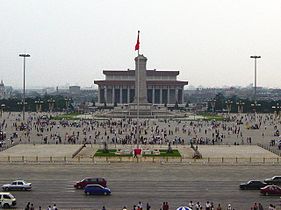
The Tian'anmen Square
· 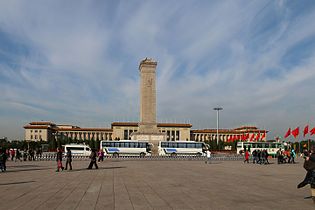
The Great Hall of the People, in the foreground the Monument to the Heroes of the People
Temples
Of the many temples, the Temple of Heaven (Tiantan) in the southern part of the Outer City is particularly noteworthy (including the Hall of Annual Prayers). There the emperor prayed every year for a rich harvest.
The complex is located in the Xuanwu district in the south of the city in the middle of a large park. The most important building of the temple is the Hall of Harvest Offerings, a building with a circular floor plan on a three-tiered marble terrace. It was built in 1420, burned down in 1889 and was rebuilt in 1890.
Other temples worth seeing are the Confucius Temple, the Lama Temple and the White Pagoda Temple.
More buildings
In the northwestern suburbs (Shisan ling) are the Ming Tombs of the emperors from the Ming Dynasty (1368-1644). These are reached by an avenue lined with marble lions, elephants, camels and horses. Northwest of the tombs (near Badaling) stands a part of the Great Wall of China.
Interesting as a relic of past times is the Old Observatory. The first observatory on this site was built by order of Kublai Khan (1215-1294) to have astronomers correct the then faulty calendar. Later, as Islamic sciences flourished, it came under Muslim control, finally passing into the hands of Christian Jesuit missionaries in the 17th century, who remained the landlords until the 1830s.
The complex features an idyllic garden and eight astronomical instruments from the Ming period - beautifully crafted armillary spheres, theodolites and the like - on the roof. Attached is a small museum with an exhibition of early astronomy-inspired pottery and navigational instruments.
Other significant landmarks include the 400-meter-high television tower built in 1992, the spectacular Central Chinese Television Headquarters, the city's tallest skyscraper at 330 meters within the China World Trade Center, the Chinese National Opera, and the numerous Christian churches. The largest and most famous among them are the Eastern Church (Wangfujing), the Western Church (Xizhimen), the Southern Church (Xuanwumen) and the Northern Church (Xishiku). Furthermore, the Imperial Summer Palace (Yihe Yuan) and the ruins of the Old Summer Palace (Yuanming Yuan) should be mentioned.
Chinese wall
Over a length of 8850 kilometers, the Great Wall of China stretches across China, a monumental structure whose construction began in the 5th century BC and continued until the 16th century. The sections that still exist today would, if placed end to end, stretch from New York to Los Angeles, and if their stones were used to build a single wall five meters high and one meter deep, the result would be a stretch longer than the circumference of the earth.
The most famous section of the wall stretches near Badaling, 70 km northwest of Beijing. It was the first section to be restored in 1957. The wall there is six meters wide and has watchtowers from the Ming period (1368-1644) at regular intervals. Its course follows the ridge of a chain of hills and could hardly have been better designed in terms of defense strategy, which is why this section was never directly attacked, but was taken over the sides.
Less well known is the Great Wall of China at Mutianyu, 90 km northeast of Beijing. The section there, built in 1368 and restored in 1983, with its numerous watchtowers is two kilometers long and stretches along a ridge of hills in a green, gently undulating landscape. Another section of the Great Wall of China is located at Simatai, 110 kilometers northeast of Beijing. Most of this wall segment, dating from the Ming Dynasty, has been left in its original state, with only a few later-period innovations, such as gun emplacements for cannons and inner wall barriers drawn across the outer wall to stop enemies who had already invaded.
Parks and green areas
In Chinese culture, the connection between dwelling and nature or recreated nature is traditionally close. However, in urban settlements, this idea has been repeatedly suppressed in favor of the highest possible utilization of scarce land, especially in recent years with the emergence of high-rise residential buildings in serial construction. Only residual areas remained for green spaces close to houses. Building densification has been so great that there has been a compensatory need for public parks, sports facilities, recreational and play areas.
Recently, the idea has taken hold that a city with a smog bell hanging over it most of the time has little future. There are two notable countermeasures: Emission control and reduction, and ventilation via green corridors. For example, it is now standard practice to create accompanying green corridors along expressways, which, at 100 to as much as 400 meters wide, even form smaller forest patches. The program to develop riverbeds and canals with wide riparian strips is a particular step forward. For example, small parks, bicycle paths and recreational facilities have been interspersed in the banks of the dammed-up river courses around Beijing, so that the residents of the new suburban settlements have recreational opportunities close to home. Even the numerous new golf courses should be mentioned here, although they are less frequented as non-public areas.
Commonly referred to as the Summer Palace, Yiheyuan is one of the most charming parks in Beijing. The huge area, two-thirds of which is a lake, served as a summer retreat for the last emperors, where they retreated together with their court during the hottest months of the year.
And the location, surrounded by hills, cooled by the lake and protected by a garden complex, is ideal. Imperial pavilions have been there since the 11th century, but most of the present complex dates from the 18th century and was built under the Manchu Emperor Qianlong.
The North Sea Park (北海公園 / 北海公园, Běihǎi Gōngyuán) northwest of the Imperial Palace is one of the typical Chinese gardens. The Jin Emperor Shizong began to build a summer palace and create this park in 1179.
Emperor Kublai Khan made it his residence in 1260, moving into the "Hall of Wide Cooling". In its place, the Qing emperors built the Lamaist "White Pagoda" from 1651, which still dominates the park today. Emperor Qianlong ordered extensive expansion work between 1735 and 1796. Almost all of today's buildings in the park date from this construction period.
Other parks include Jingshan Park and Ditan Park. In the mountains west of the city are several parks, such as Badachu and Fragrant Hill Park. In addition, the new and old Beijing Botanical Garden with the Valley of Cherries is also located there. The Beijing Zoo is also worth seeing, not only for the giant panda, but also for the aquarium.
To the southwest is Beijing World Park, which covers about 40 hectares. Here you can see scaled-down replicas of many world-famous ancient and modern buildings and architectural ensembles from all continents, for example, from the Egyptian pyramids to the Eiffel Tower and the sunken New York World Trade Center.
Since 2001, a park and recreational landscape that goes beyond all previous projects has been created in the west: starting south of the Marco Polo Bridge, a drained riverbed was first laid out over a length of 20 km and a width of between 0.8 and two kilometers with public green spaces, smaller lakes and several golf courses. To the south, further areas are already being prepared as an extension of this green lung. 14 km to the northwest, the river bed, which narrows here, is being transformed in the same way into a park landscape with a particularly large number of water areas. By the end of 2010, about 60% of the work had already been completed. Once all the facilities have been completed beyond the southwestern city limits (around 2020), there will one day be around 80 square kilometers of a landscape park close to the city and around 55 kilometers long. The art landscape, which is probably unique in the world, is located between 18 and 42 kilometers from the center of Beijing.
Culinary specialties
Nowhere on the Chinese mainland is the culinary diversity greater than in Beijing. In addition to all Chinese cuisines, almost all Asian and most world cuisines are represented here. In view of this abundance, it is often not noticed that Beijing itself has its own cooking tradition and makes a tasty contribution with specialties such as Peking duck (北京烤鴨 / 北京烤鸭, běijīng kǎoyā) and Mongolian fire pot (火鍋 / 火锅, huǒguō).
Served in Chinese restaurants around the world, Peking duck consists of small pieces of meat dipped in sweet black bean sauce (甜麵醬 / 甜面酱, tián miànjiàng) and then rolled into a kind of flour dough pocket with chopped scallions.
Another well-known dish is the Mongolian fire pot, in which mutton cut into thin strips, along with shrimp, cabbage (and other vegetables) and noodles, are tipped into a pot of boiling broth, usually kept at cooking temperature from below. The rest is sometimes drunk as soup at the end.
Sports
Beijing hosted the 2008 Summer Olympics and was also selected to host the 2022 Winter Olympics.
For the 2008 Summer Olympics, massive investments were made in the city's sports infrastructure. Among the numerous new buildings is the Olympic Stadium, whose sensational architecture made it a new Beijing landmark even during the construction phase. The Workers' Stadium is one of the monumental buildings erected to mark the tenth anniversary of the founding of the People's Republic of China in 1959. The Beijing Guoan Football Club plays in the Chinese Super League.
As in the whole country, the Chinese national sport table tennis is popular in Beijing, the last world championship in Beijing was held in 1961.
Nanshan Ski Village is located about 65 km northeast of Beijing and is a popular winter sports resort.

Logo of the Olympic Games 2008

Beijing Guoan in a home match at Fengtai Stadium
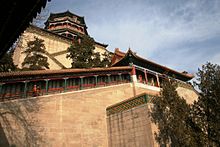
Staircase in the Summer Palace
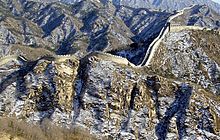
Great Wall of China in Badaling near Beijing

Xishiku Church
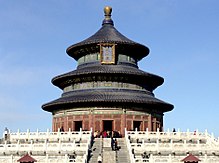
The Hall of Harvest Prayer, part of the Temple of Heaven
Nine Dragons Wall in the Forbidden City
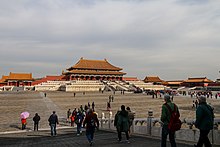
Facilities in the Forbidden City

Historical map of Beijing around 1700 - Kangxi era
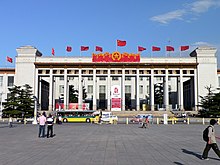
Chinese National Museum
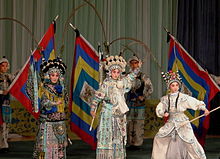
Peking Opera
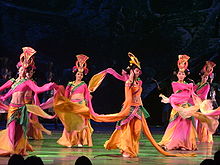
Peking Theater

Huguang Guild House, Theater and Museum
Economy and infrastructure
Economy
According to a 2014 study, Beijing generated a gross domestic product of 506.1 billion US dollars (GDP). In the ranking of the economically strongest metropolitan regions worldwide, it thus occupied 11th place. GDP per capita was 23,390 U.S. dollars, making Beijing one of the richest cities in China. Beijing is the city with the highest number of Fortune Global 500 companies.
Beijing is now the second largest industrial center in the country. Major industries have been located in satellite cities: petrochemical manufacturing in Fangshan, machinery manufacturing in Fentai, iron and steel manufacturing in Shijingshan, and motor vehicle manufacturing in Tongxian.
Over two million workers in the province are employed in industry. Clothing, canned goods, cotton and synthetic fabrics, paints, paper, lubricants and electronic products are produced. Since the beginning of economic reforms in 1978, the construction industry has become increasingly important. It employs about 700,000 construction workers.
About 900,000 people work in agriculture in the city, which is not part of the government. Agricultural products include poultry and pork, cereals, vegetables (cabbage, tomatoes, eggplants, carrots and onions), milk and eggs.
Numerous commercial and service enterprises have settled in Beijing in recent years (over one million employees). The city is a shopping and fashion center. There are several modern shopping districts (for example, on Wangfujing Street). Traditions include gold enamel work (cloisonné), jade carving and carpet weaving.
Since the economic reforms of the 1980s and 1990s, there have also been enterprises supported by foreign investors. Many private enterprises have emerged. In Beijing, there are about 100,000 privately employed workers (getihu) in commercial enterprises. The service industry has more than 30,000 businesses with about 200,000 employees.
In a ranking of the world's most important financial centers, Beijing ranked 11th (as of 2018).
Traffic
Railroad traffic
As a transportation hub, Beijing has airports and rail links to all parts of the country, as well as an intercontinental route via the Trans-Mongolian Railway (Ulan Bator) and the Trans-Siberian Railway to Europe. Beijing plays a central role in the expansion and new construction plans for the state railroad's high-speed rail service.
Air traffic
Beijing Capital Airport is located in the Shunyi area about 20 kilometers northeast of the city center.
In 2011, it was announced that another airport, Beijing-Daxing Airport, with a capacity of 120 million passengers and up to seven runways, was in the planning stage; it opened on schedule on September 25, 2019. Beijing-Daxing is among the largest airports in the world.
In the south of the city, Beijing-Nanyuan, another smaller airport with about one million passengers per year, was located until the opening of the new major airport in 2019.
Imperial Canal
Beijing is connected to the Yellow River (黄河, Huáng Hé) and the Yangtze River via the Imperial Canal.
Road traffic
Beijing is connected to other cities in China by nine highways. The Beijing highway network is constantly being expanded. Five ring roads and some thoroughfares are available for inner-city traffic. One classifies the city center as the part of Beijing that lies within the 2nd ring road and the greater Beijing area as the part that lies within the 5th ring road.
Similar to Moscow, Beijing is developing in the form of rings. This has brought problems for road traffic. Traffic jams are frequent, and new construction and expansion of ring roads does not seem to solve the traffic problem.
Bus and streetcars
Inner-city public transportation exists in the form of nearly one thousand bus and trolley lines. The first trolley bus ran in the city on February 26, 1957. The first electric streetcars ran in Beijing on June 24, 1899, but service was suspended during the Boxer Rebellion on June 13, 1900. On December 17, 1924, the system was reintroduced. This time, the streetcars ran until May 6, 1966.
Subway
The first section of the Beijing subway was opened on October 1, 1969. After that, the system was expanded only very slowly. It was not until several subway lines were put into operation in 2008 for the Olympic Games that the network grew to eight lines. This represented the start of a rapid expansion, so that by 2010 there were already 14 lines. Further major expansions are planned for 2014 to 2020. Currently (as of December 2014), the route network measures 527 km.
A one-way ticket costs the equivalent of about 90 cents. (As of January 2018)
Bicycle traffic
For a long time, the bicycle had a prominent role in Beijing as an inner-city means of transportation, with dedicated bike lanes for the approximately ten million private bicycles. More recently, it has been increasingly displaced by private cars. In order to reduce air pollution, traffic congestion as well as bicycle theft, the city government is now focusing on the development of a network of bicycle rental stations, which provided 50,000 bikes by the time of the 2008 Summer Olympics. Thanks to the emergence of a number of dockless app-based bike rental systems such as Mobike, Bluegogo and Ofo, cycling has regained much of its popularity.
→ Main article: Beijing bicycle rental system
Education
Of the city's many institutions of higher learning, Peking University (北京大學 / 北京大学, Běijīng Dàxué, founded 1898) and Tsinghua University (清華大學 / 清华大学, Qīnghuá dàxué, founded 1911) are the best known. Also known nationwide are Chinese People's University (人民大學 / 人民大学, Rénmín dàxué), the University of Foreign Economics and Trade (對外經濟貿易大學 / 对外经济贸易大学, Duìwaì Jīngjì Màoyì Dàxúe), and Beijing University of Education (北京師範大學 / 北京师范大学, Běijīng Shīfàn Dàxué). At BLCU (北京語言文化大學 / 北京语言文化大学, Běijīng yǔyán wénhuà dàxué, formerly Language Institute; founded 1962), about three-quarters of the students are foreigners studying Chinese.
Equally interesting is Beijing Sports University (北京體育大學 / 北京体育大学, Běijīng tǐyù dà xué), the most important sports university in China, popular with foreigners especially for studying wushu, often in combination with language studies. In addition, there is the Chinese Academy of Sciences and a number of research institutes under it. Beijing Foreign Language University (北京外國語大學 / 北京外国语大学, Běijīng wàiguóyǔ dàxué) is one of the best foreign language universities in the country.
China Central Academy of Fine Arts is the name of the art academy in Beijing, it is the oldest art academy in China. The Research Institute of Music of the Academy of Fine Arts of China is also located in Beijing.
More than 250,000 people are employed in the scientific and technical sector. Around 500,000 people are employed in education and communications. The Beijing Library is the most important in the People's Republic of China (approximately ten million volumes; with holdings from the libraries of the Sung, Yuan, Ming and Qing dynasties).
Most universities are located in the Haidian district (海澱區 / 海淀区, Hǎidiàn qū) in the northwest of the city. There are more than twenty universities there alone.
See also: List of secondary educational institutions in Beijing
Healthcare
The China Rehabilitation Research Center is a government rehabilitation clinic in Beijing and also a center for education and research in the field of rehabilitation in China.
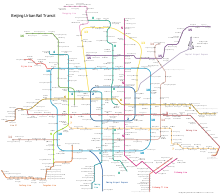
Beijing subway network

Cosco building
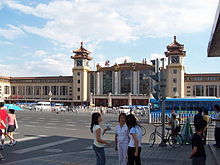
Beijing train station

Wangfujing Street
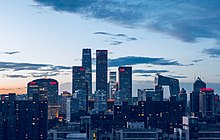
Beijing Business District

Tsinghua University
Personalities
→ Main article: List of personalities of the city of Beijing
Beijing was the birthplace of many prominent personalities. The most famous include the Emperors of China, Qianlong and Puyi, Empress Dowager Cixi, World Chess Champion Xie Jun, actors Ivan Desny, Jet Li and Zhang Ziyi, writers Shan Sa and Lao She, and singer and actress Faye Wong.
To date, around twenty people have been appointed honorary citizens of the city of Beijing. Most of these are people residing in Hong Kong, among them numerous owners of large corporations (tycoons). Some honorary citizens come from abroad, including two Germans, the film producer Manfred Durniok (1934-2003) and the piano designer Lothar Schell.
See also
- Monuments of the People's Republic of China (Beijing)
- Monuments of the Government Immediate City of Beijing
Questions and Answers
Q: What is Beijing?
A: Beijing is the capital of the People's Republic of China.
Q: What was Beijing known as previously?
A: Beijing was known as Peking.
Q: Where is Beijing located?
A: Beijing is located in the northern and eastern parts of China.
Q: What is the population of Beijing?
A: Nearly 15 million people live in Beijing.
Q: What is the importance of Beijing in the development of China?
A: Beijing has played a very important role in the development of China.
Q: What is Beijing well known for?
A: Beijing is well known for its ancient history and there are many places of historic interest in Beijing.
Q: Which major sporting events has Beijing hosted and will host in the future?
A: Beijing has hosted the Summer Olympic Games in 2008 and will host the 2022 Winter Olympic Games, making it the only city to host both.
Search within the encyclopedia